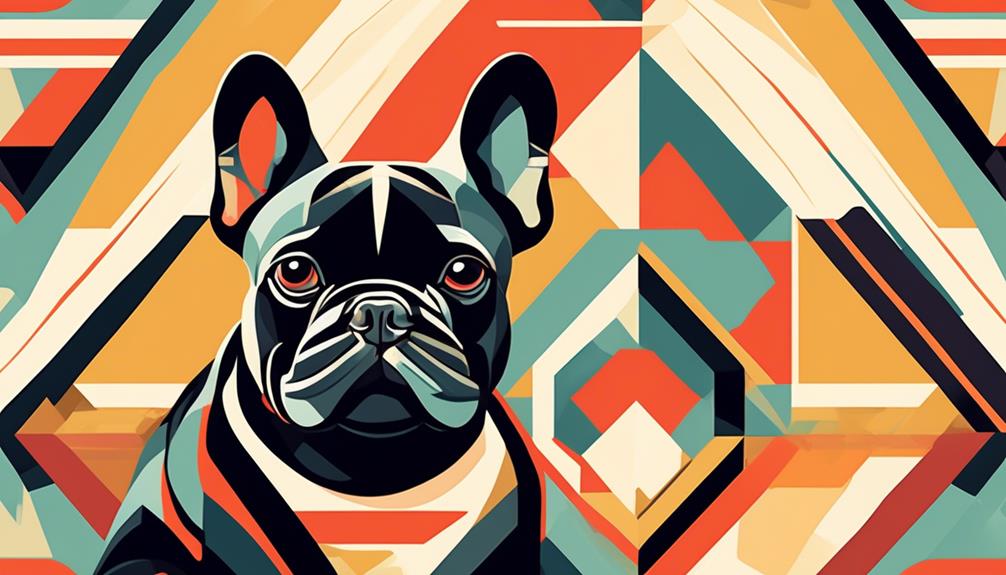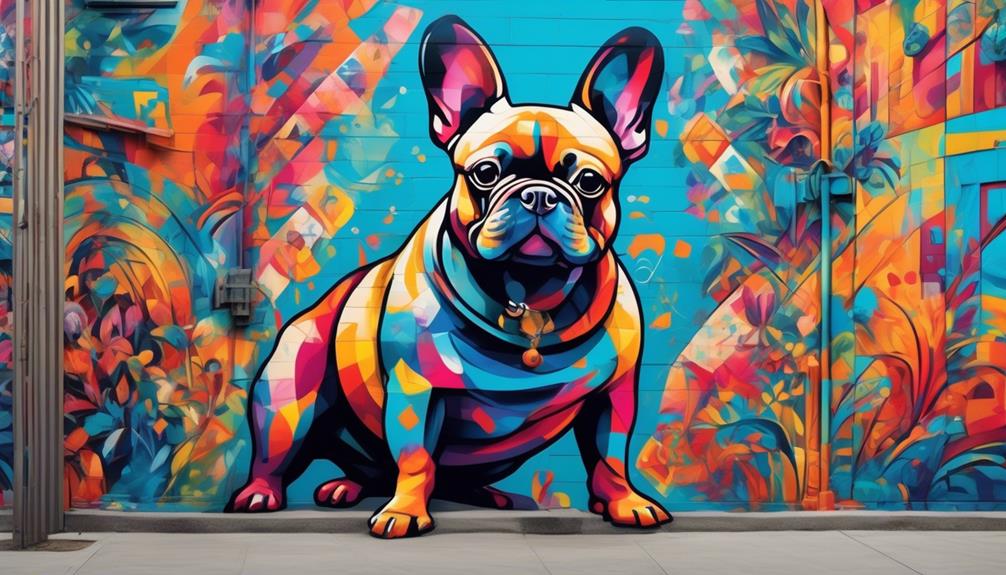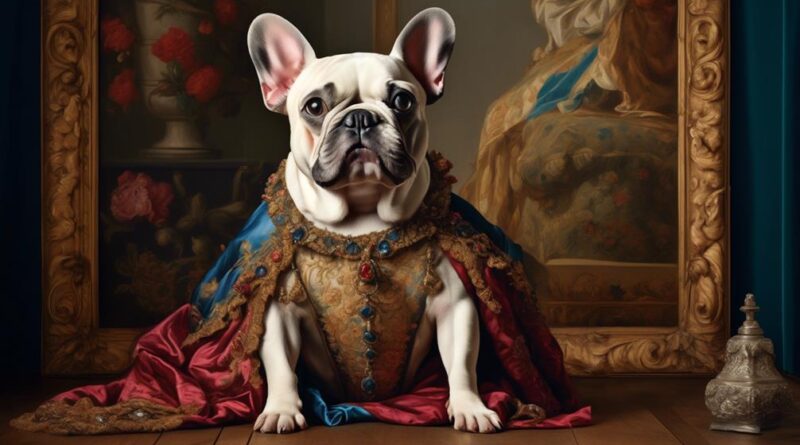What Role Did French Bulldogs Play in Historical Art?
You may have heard of Napoleon Bonaparte's fondness for French Bulldogs, often depicted alongside him in portraits and statues, symbolizing his tenacity and determination.
But did you know that these endearing, bat-eared companions have also left their mark on the world of art throughout history?
From their presence in Renaissance paintings to their portrayal in contemporary street art, French Bulldogs have held a unique role in artistic expression.
Their significance goes beyond mere companionship, weaving into the fabric of art movements across centuries.
Their influence is a fascinating and often overlooked aspect of art history, shedding light on the evolving relationship between humans and their loyal canine counterparts.
French Bulldogs in Renaissance Paintings
French Bulldogs were often depicted in Renaissance paintings as cherished companions of the nobility, reflecting their status and affection for these beloved pets. During the Renaissance period, dogs were a popular subject in art, and French Bulldogs, known for their loyalty and companionship, held a special place in the hearts of the nobility.
These dogs weren't only valued for their loyalty but were also used as symbols of power and influence. As a result, they were frequently included in portraits of the aristocracy, serving as a representation of their wealth and social standing.
In addition to their role as symbols of status, French Bulldogs were also featured in Renaissance paintings due to their unique physical characteristics. The breed's distinctive bat-like ears, compact size, and expressive eyes made them compelling subjects for artists seeking to capture the essence of their noble patrons. These charming features endeared French Bulldogs to the nobility, further solidifying their place in the art of the era.
Furthermore, French Bulldogs were among the select few dog breeds that gained popularity during the Renaissance period. Their presence in paintings from this time serves as a testament to the breed's enduring appeal and its close association with the elite class.
As such, these beloved pets played a significant role in the artistic representation of the noble families of the Renaissance, leaving an indelible mark on the era's cultural legacy.
French Bulldogs in Baroque Sculptures
Baroque sculptures often featured the endearing and distinctive physical traits of the French Bulldog, captivating viewers with their expressive features and elegant posture. During the Baroque period, French Bulldogs were highly popular subjects in sculptures due to their symbolic significance. These sculptures often portrayed the Bulldogs in various roles, representing different virtues and qualities.
The Bulldog symbolism in Baroque sculptures exemplified attributes such as loyalty, courage, and determination. Artists utilized the distinct appearance of French Bulldogs to convey these traits, sculpting them with strong, muscular bodies and alert, focused expressions. These depictions served as visual metaphors for the admirable qualities that the Bulldogs embodied, making them poignant additions to Baroque artworks.
French Bulldog's popularity during the Baroque period stemmed from their association with the elite and aristocracy. The breed was often favored by influential figures, including members of royal courts and prominent families. As a result, French Bulldogs became a symbol of status and sophistication, leading to their frequent portrayal in lavish Baroque sculptures that adorned palaces and grand estates.
French Bulldogs in Victorian Portraiture
Portraying the beloved French Bulldog in a new light, Victorian portraiture captured the breed's endearing qualities with a refined elegance that mirrored its earlier depictions in Baroque sculptures. During the Victorian era, French Bulldogs were often featured in portraits alongside their owners, showcasing the deep bond of canine companionship. These portraits not only highlighted the affection between the dog and its owner but also symbolized the aristocratic status of the breed's owners.
French Bulldogs in Victorian portraiture held significant symbolic importance in the realm of animal portraiture. The inclusion of these charming companions in formal portraits signified the esteemed position they held within the family and society. The breed's portrayal in these artworks reflected the growing trend of considering pets as cherished members of the family rather than mere possessions. The French Bulldog's presence in Victorian portraits represented a shift in attitudes towards animals and their roles within the household, emphasizing the emotional connection and companionship they provided to their owners.
The artistic representation of French Bulldogs in Victorian portraiture served as a testament to their esteemed status and the meaningful relationships they shared with their human counterparts. Through these portraits, the breed's endearing qualities and aristocratic associations were immortalized, contributing to the rich tapestry of historical art and the evolving significance of canine companionship in society.
French Bulldogs in Impressionist Art
Capturing the charm and character of the beloved French Bulldog, Impressionist artists infused their works with a sense of lively movement and emotion. In the world of Impressionist art, French Bulldogs made their mark as delightful subjects, often depicted in everyday scenes with their owners. These artists, such as Pierre-Auguste Renoir and Édouard Manet, portrayed the endearing qualities of French Bulldogs through their loose brushwork and emphasis on light and color.
French Bulldogs in Impressionist art often appeared in casual, outdoor settings, reflecting the breed's playful nature. These paintings highlighted the bond between humans and their furry companions, showcasing the Bulldogs as cherished members of the family. The loose, spontaneous style of Impressionism allowed artists to capture the energy and vivacity of these beloved pets, creating timeless and heartwarming portrayals.
Furthermore, the charm of French Bulldogs continues to inspire contemporary artists, with the breed appearing in various forms of modern art. In the realm of contemporary photography, French Bulldogs are often featured as adorable and photogenic subjects, adding a touch of whimsy to visual compositions. Additionally, French Bulldogs have found their place in abstract expressionism, with artists using bold, dynamic strokes and vibrant colors to convey the lively spirit of these beloved companions.
French Bulldogs in Art Deco Illustrations

Art Deco Illustrations beautifully showcase the elegance and sophistication of French Bulldogs, often portraying them as symbols of modernity and luxury. In the 1920s and 1930s, the Art Deco movement influenced various forms of art, including illustrations, where French Bulldogs were depicted in sleek, geometric forms that reflected the style's emphasis on luxury and modern design. These illustrations captured the essence of the French Bulldog, emphasizing its distinctive traits in a bold and stylized manner.
Art Deco interpretations of French Bulldogs hold historical significance as they not only epitomized the era's fascination with luxury and elegance but also reflected the cultural shift towards modernity. The breed became a popular subject in Art Deco illustrations, symbolizing prosperity and urban sophistication. The clean lines, bold colors, and streamlined aesthetic of Art Deco perfectly complemented the unique characteristics of French Bulldogs, creating visually striking representations that left a lasting impact on the art world.
Furthermore, the influence of French Bulldogs in Art Deco illustrations extended beyond the realm of art, permeating into modern design and popular culture. The cultural impact of these illustrations solidified the French Bulldog's association with luxury and style, a perception that continues to endure today. The breed's depiction in Art Deco art contributed to its enduring appeal and representation as a timeless symbol of elegance and modernity.
French Bulldogs in Modern Pop Art
Modern Pop Art vividly showcases the playful and vibrant presence of French Bulldogs, infusing their iconic features with contemporary flair. Their endearing characteristics have made them a staple in modern pop art, captivating audiences and adding a touch of whimsy to the genre.
Here's how French Bulldogs have become iconic in modern pop art:
- Expressionistic Portrayals: Artists often depict French Bulldogs with exaggerated features, such as oversized ears and bulging eyes, to convey a sense of liveliness and exuberance. These expressive portrayals capture the essence of the breed's spirited nature, adding a dynamic energy to the artwork.
- Colorful Interpretations: In contemporary pop art, French Bulldogs are often depicted in bold and vibrant colors, reflecting the influence of consumer culture. These eye-catching hues not only draw attention to the artwork but also emphasize the breed's playful and mischievous demeanor.
- Collage and Mixed Media: Artists frequently incorporate French Bulldogs into collage and mixed media pieces, seamlessly blending the traditional with the modern. This juxtaposition of elements mirrors the breed's ability to seamlessly integrate into diverse environments, making them a fitting subject for contemporary art forms.
- Iconic Pop Culture References: French Bulldogs are often portrayed in modern pop art alongside iconic symbols of consumerism, such as fast food, fashion, and technology. This juxtaposition serves as a commentary on the pervasive influence of consumer culture and the breed's status as a beloved and fashionable companion.
The depiction of French Bulldogs in modern pop art serves as a testament to their enduring popularity and cultural significance, cementing their status as beloved muses in the art world.
French Bulldogs in Contemporary Street Art

The contemporary street artist's use of French Bulldogs as subjects infuses urban landscapes with a playful and endearing charm, captivating passersby with the breed's unmistakable charisma. French Bulldogs have become an iconic symbol in urban graffiti, representing the fusion of contemporary art and urban culture. Street art has evolved to embrace the French Bulldog as a recurring motif, showcasing the breed's unique appeal and resonating with modern audiences.
In the realm of urban culture, the French Bulldog has become a prominent feature in street art, adorning walls and alleyways with its distinctive and lovable visage. Artists utilize the breed's expressive face and compact yet muscular physique to create captivating murals that reflect the vibrancy of contemporary urban life. The French Bulldog's presence in street art serves as a reflection of the breed's widespread popularity and its ability to seamlessly integrate into diverse cultural contexts.
The contemporary street artist's portrayal of French Bulldogs in urban settings not only celebrates the breed's charm but also adds an element of whimsy and delight to city landscapes. Through bold and expressive depictions, these artists bring the endearing qualities of French Bulldogs to the forefront, fostering a sense of connection and joy among viewers. As a result, the French Bulldog has solidified its place within the fabric of contemporary street art, leaving an indelible mark on the visual tapestry of urban environments.
French Bulldogs in Digital Art and Memes
French Bulldogs' endearing presence in contemporary street art has extended beyond physical urban landscapes, finding new life in the realm of digital art and memes. The charm and playfulness of French Bulldogs have made them a popular subject in digital art, often depicted in vibrant colors and bold lines that capture their lively spirit.
In the world of memes, French Bulldogs have become iconic symbols, representing various emotions and quirky behaviors that resonate with pop culture. Here's why French Bulldogs have made such a splash in the digital world:
- Adaptability: French Bulldogs' expressive faces and comical antics make them perfect subjects for memes, as they can be easily adapted to convey a wide range of emotions and relatable situations.
- Virality: Their widespread appeal has led to the creation of countless memes featuring French Bulldogs, which quickly gain traction on social media platforms, spreading their popularity even further.
- Cultural References: French Bulldogs have become embedded in internet culture, often referenced in jokes, viral videos, and online conversations, solidifying their place in the digital landscape.
- Social Media Presence: Whether it's Instagram, Facebook, or Twitter, French Bulldogs have amassed dedicated followings, with accounts featuring their antics garnering thousands, if not millions, of followers.
Their prevalence in digital art and memes showcases how French Bulldogs haven't only maintained their relevance but have also become influential figures in the modern online sphere, shaping and reflecting current trends in pop culture and social media.
Frequently Asked Questions
Are French Bulldogs Depicted Differently in Renaissance Paintings Compared to Modern Pop Art?
In Renaissance paintings, French Bulldogs were often depicted as regal and refined companions to aristocrats, reflecting the breed's association with nobility. Historical depictions emphasized the breed's elegance, while contemporary representations showcase their adorable and fun-loving nature.
In contrast, modern pop art portrays French Bulldogs in a more playful and whimsical light, capturing their endearing charm. These shifts in portrayal highlight the evolving cultural perceptions and roles of French Bulldogs in art across different time periods.
How Did French Bulldogs Become a Popular Subject in Victorian Portraiture?
Victorian influence greatly impacted the artistic evolution of French bulldogs as a popular subject in portraiture. Their endearing qualities and unique appearance captured the attention of artists during this era, leading to a surge in their representation in art.
The Victorian fascination with pets as companions and symbols of status also contributed to the rise of French bulldogs in portraiture, solidifying their place in historical art.
What Role Did French Bulldogs Play in Baroque Sculptures and Why Were They Included in This Art Form?
French bulldogs were significant in baroque sculptures due to their representation of loyalty and companionship. Their inclusion in this art form reflects the historical significance of these traits.
The artistic representation of French bulldogs in baroque sculptures has also influenced modern interpretations, similar to their role in renaissance paintings.
The presence of these beloved canines in historical art showcases the enduring appeal of these animals and their impact on artistic expression throughout history.
How Have French Bulldogs Been Portrayed in Contemporary Street Art Compared to Their Depictions in Impressionist Art?
In contemporary graffiti, French Bulldogs are often depicted with bold colors and exaggerated features, reflecting a more urban and modern style. This contrasts with their portrayal in impressionist paintings, where they were often depicted in more natural settings with softer and realistic features.
The shift in portrayal reflects the changing cultural and artistic influences over time, from historical portraits to street art.
What Impact Has the Rise of Digital Art and Memes Had on the Portrayal of French Bulldogs in Art?
The rise of digital art and memes has significantly impacted the portrayal of French Bulldogs in contemporary art.
With the influence of social media, these adorable dogs are often depicted in a more playful and humorous light, compared to their traditional portrayal in impressionist art.
Digital art allows for more creative and diverse representations, while memes have popularized the breed in a way that transcends traditional art forms.
Conclusion
So, as you can see, French Bulldogs have made their mark in historical art across various periods and styles.
From Renaissance paintings to modern pop art, these beloved dogs have been immortalized in different artistic mediums.
Their presence in art reflects the enduring popularity and cultural significance of French Bulldogs throughout history.
Whether as symbols of wealth, companionship, or simply as charming subjects, these dogs have left a lasting impression on the art world.
